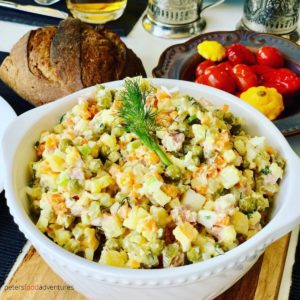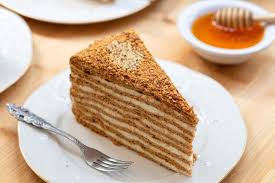Recipes
Roza's War contains a lot of references to food, some of it quite tasty! I've tried out all of these recipes and thought you might like to as well.
Russian Tea Cakes

Makes approximately 36 cookies
Ingredients
- 1 cup unsalted butter, softened
- 1 teaspoon vanilla extract
- 2 cups all-purpose flour
- 6 tablespoons powdered sugar
- 1 cup finely chopped walnuts
- ⅓ cup powdered sugar, or more as needed
Steps
- Preheat the oven to 350 degrees F (175 degrees C).
- Cream butter and vanilla together in a medium bowl with an electric mixer until smooth, 2 to 3 minutes.
- Whisk flour and 6 tablespoons powdered sugar together in separate bowl. Add to the butter mixture and stir until just blended. Add walnuts and mix until incorporated; mixture may be crumbly.
- Take small scoops of dough and roll between your hands into 1-inch balls. Place balls 2 inches apart on ungreased cookie sheets.
- Bake in the preheated oven until edges are just turning golden, about 12 minutes.
- Remove from the oven and transfer to a wire rack to cool for 15 minutes.
- Place remaining 1/3 cup powdered sugar in a small bowl. Roll cooled cookies in the powdered sugar once or twice.
Kasha
In Russia, kasha is a versatile dish that can be savory, served with meat and gravy, or sweet, prepared with honey and fruit.
In Roza's War, the soldiers often have kasha for breakfast, so the recipe here is for a sweet breakfast porridge.

Makes 2 hearty servings
Ingredients
- 1 cup roasted buckwheat groats
- 2 cups boiling water
- ½ teaspoon salt
- 2 teaspoons honey or sugar
- 2 tablespoons butter
- 2-3 cups milk
- Fresh or frozen fruits
Steps
- Wash the toasted buckwheat groats, like you would wash rice.
- In a medium saucepan, add the buckwheat, 1 tablespoon butter and boiling water.
- Bring mixture to a boil. Reduce to a simmer, cover and cook until tender, about 15 minutes.
- Mix in salt, 1 tablespoon butter and honey.
- Add milk to the cooked buckwheat. Return to heat to warm up. Serve with honey and fresh fruit.
Olivier Salad
Olivier Salad is a delicious Russian Potato Salad that's popular during the holidays or any special occasion.
Around the world it's known as салат Оливье, Olivye, Ensalada Rusa, Rus Salatası, ρώσικη σαλάτα, bramborový salát and more. It does require a bit of time
and effort, but most people absolutely love the result.

Makes 10 servings
Ingredients
- 1 lb (½ kg) Ham or Smoked Chicken Breast (leave out the meat for a perfectly delicious vegetarian dish)
- 4 medium potatoes peeled
- 4 carrots peeled
- 5 hard-boiled eggs diced
- 5 medium-sized dill pickles
- ⅓ cup green onion optional
- ½ small onion finely diced
- 1 bunch fresh dill chopped
- 1 ½ cups mayo
- 1 can of peas drained
- salt and pepper to taste
Steps
- Boil potatoes and carrots. I put the potatoes in first, for about ten minutes, then add the carrots. Cook until soft, but be careful not to overcook them so they don't turn to mush. Cool the vegetables with ice water.
- Hard boil the eggs for about 11 minutes. Cool and peel.
- Chop the potatoes, carrots, eggs, pickles, and ham into small pea size pieces. (try to keep everything the same size approx ¼").
- Finely dice the white onion and fresh dill.
- Mix together the potatoes, carrots, eggs, pickles, ham, onion, mayonnaise and fresh dill. Taste, season and add more mayo if needed.
- Carefully fold in the canned peas without crushing them. Refrigerate and enjoy!
Medovik
This Russian honey cake is melt-in-your-mouth delicious! It does require a fair amount of time and effort, but it's worth it.

Makes one cake
Ingredients
- 1/2 cup butter
- 3/4 cup sugar
- 2 eggs
- 2 teaspoons baking soda
- 1/4 cup honey
- 3 1/2 - 4 cups all purpose flour
- 1/2 package cream cheese (4oz)
- 1/2 can sweetened condensed milk (7oz)
- 16oz sour cream
- 1 teaspoon vanilla
- 1 cup heavy cream
- 2 tablespoons powdered sugar
- Optional: fresh rosemary
- Optional: red currants or cranberries
- Optional: 1 cup water
- Optional: 1 cup plus 1/2 cup sugar
Steps
Make the cake layers:
- Place the butter and sugar in a large nonstick pot. If you don’t have a nonstick pot, or your pot burns easily, you may wish to use a double boiler. (Just place a metal or glass bowl on top of a pot with about an inch or water in it and keep it simmering, but make sure the bottom on the bowl never touches the simmering water. Add more water if it evaporates.
- Cook it just until the butter melts but is still barely warm, NOT HOT.
- Take it off the heat. Add the eggs, baking soda and honey and mix to combine.
- Cook the mixture on medium low heat for about 7 minutes, longer if you’re using a double boiler. The batter will almost double in size and will turn a deep caramel color. Take it off the heat.
- Add the flour and mix quickly with a wooden spoon. I always add less flour than I need and add more when I’m rolling out the cake layers. If you add too much flour, it will be really hard to roll out.
- Preheat oven to 350 degrees.
- On a lightly floured surface, roll out the cake layers.
- Take approximately 1/4 cup of batter and knead it on your work surface. If it’s sticking to your hands and the counter, add more flour. Roll it out thinly into somewhat of a circle.
- Use the bottom of a cake pan or the bottom of a tart pan to cut a perfect circle (save the scraps.)
- Bake one cake layer on a cookie sheet lined with parchment paper or Sylpat for 4 minutes. Set aside.
- While the batter is still warm, roll, trim and bake each cake layer until you use up your batter or end up with 10-12 layers.
- Bake the scraps that you trimmed from the layers for 7 minutes or until golden. Crush them into crumbs.
Make the frosting:
- Cream the softened cream cheese and condensed milk in a standing mixer with a paddle attachment or using a hand mixer until it’s well combined.
- Add the sour cream and vanilla and mix to combine.
- In another bowl, whip the heavy cream with the powdered sugar.
- Gently fold the whipped cream into the rest of the frosting.
Assemble the cake:
- Dust off any excess flour from the cake layers.
- Line your serving plate edges with aluminum foil.
- Place a dollop of frosting into the center of the plate, to keep the cake from sliding around.
- Top each cake layer with about 1/4 cup of frosting and spread it around evenly.
- Repeat with all the cake layers. As you place the layers on top of each other, some of the frosting will ooze out of the sides. Spread it out evenly over the sides.
- Sprinkle the baked, crushed cake layer scraps over the sides of the cake. If you're not doing the optional sugared decorations, sprinkle cake crumbs over the top of the cake as well.
- Carefully remove the aluminum foil.
Optional decorations:
- Heat 1 cup water and 1 cup sugar in a small saucepan just until the sugar dissolves. Pour it into a shallow dish.
- Place about 1/3 – 1/2 cup of sugar in another shallow dish.
- Dip the rosemary and the red currants in the sugar syrup and dip it in the sugar.
- Place on a parchment paper to dry and then place it on the cake.
- Admire your lovely cake!